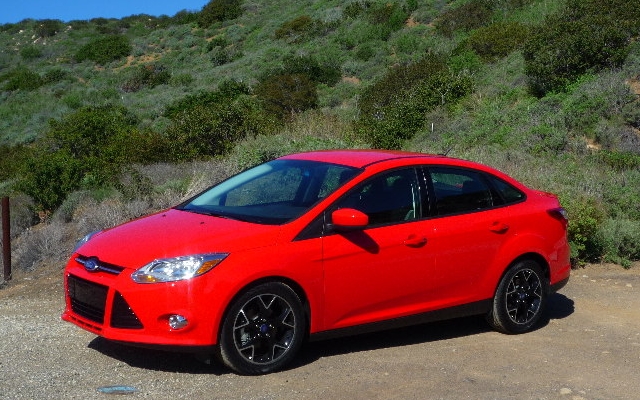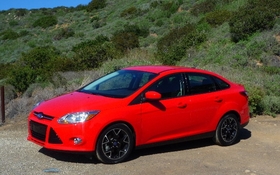2012 Ford Focus: Ford’s on the comeback trail

| Strong points |
|
|---|---|
| Weak points |
|
In 2000, in its infinite wisdom, Ford management decided to replace its popular Escort with the Focus. It featured a brand new European-designed platform, an interesting range of engines and a modern shape. Moreover, the line-up included a very useful and well-liked wagon.
The Focus made a great first impression, but its somewhat questionable reliability tarnished this little car’s reputation. Fortunately, Ford made the necessary changes and refined this model over the years. On the European market however, this car underwent improvements that included a more modern platform. When the North American version was updated a little over three years ago now, people were quite disappointed to discover that it still had its original platform, which was several years old at that time. Even worse, the wagon had been eliminated and there was only one engine choice. In fact, the only big innovations on this model were its slightly modified body and the inclusion of the SYNC voice command system. On a positive note, while this newcomer wasn’t the most modern or the most technologically advanced, it featured good quality for the price and what had become unquestionable reliability.
But as you surely know, Ford management is now a whole lot sharper than it used to be. So much so that the new Focus platform features cutting-edge mechanics and electronic driving aides. For the time being, a sedan and a five-door hatchback will be the first of this new generation to test the North American market. And halleluiah, a wagon will also be offered a little later.
Style
As for the shape, the stylists designed the sedan in such a way that it almost passes for a hatchback. With its high baggage hold and the little spoiler on it, it seems like it could be a five-door. However, the car is shorter and tail lights are very different – the hatchback’s are more prominent and larger. And speaking of the five-door, this model’s fuel neck access cover, which is integrated into the side panel, is a stroke of design genius. To open it, you simply press on the little triangle. The same wasn’t possible on the sedan, so it has an obvious circular opening instead.
This car’s most prominent visual feature is the front grille and the large air intake underneath it. It almost seems as though the designers drew their inspiration from the front ends of Formula 1 race cars! The passenger compartment includes quality materials and the finish is impeccable. Note that the plastic used on the dashboard is smooth and not easily scratched. Its look respects the current trends with a triangular control unit placed under a small display screen for the versions that are not equipped with the navigation system, while the swankier versions have one big central button that controls the Sony audio system. The other functions are found on the large LED touch-screen that also acts as a navigation screen.
There are two gauges in front of the driver and a screen between the two to access information and display the route from the navigation system. The fuel and temperature gauges are below this display. But what impressed me most was the comfortable steering wheel decorated with very nice chrome accents and featuring multiple controls on its circumference to manage the main systems, from voice communication to cruise control and a whole lot more.
We drove the Focus on wonderfully sinuous roads and found that the seats were comfortable and offered excellent lateral support. The back seats are comfortable too, but the leg room is quite limited. At the presentation of this new model, we were able to drive a sedan and a five-door version. The sedan was an SE equipped with nice accessories, in particular the Sport package that includes painted alloy rims and rear wheel disc brakes. This version came with a five-speed manual transmission. As for the hatchback, it was the much snootier Titanium version with its better equipment level, including the navigation system, the MyFord Touch, a quality Sony audio system and the SYNC system.
For now, only one engine is offered, a 2.0-litre direct injection four-cylinder with 160 horsepower. After driving more than 250 kilometres in the new Focus, we can confirm that the handling is excellent. The roll is under control and car is practically neutral in turns. Only in very tight turns can you detect a slight understeer. We drove these two cars on roads that were quite hard on the brakes, but they did not overheat and remained stable. The electric power steering is good in general. But during our alpine pilgrimages, it was a tad overmatched at times. For everyday traffic, however, it’s more than up to the task.
As for the engine itself, its performances are satisfactory. It has been criticized for a lack of torque in low gear, but in its defence, the five-speed manual gearbox has two overdrives. To get a little more muscle and pick-up, you’ll have to gear down to third. In fact, it’s a necessity for passing safely. Although the clutch is progressive and the shifting precise, it’s not always perfect, so you’ll have to play with the stick shift and harmonize the engine speed with the road conditions to get the engine out of trouble. The engineers seem to have better calibrated the six-speed twin-clutch automatic gearbox. Note, by the way, that this transmission comes with a Sport mode that helps get the most out of the engine. And, what’s more, it downshifts automatically when going downhill in order to maintain a constant speed. It’s very good. However, at low speed in traffic, this transmission sometimes tends to shift into the two lower gears with a sharp jolt.
Overall, this is a nice car in almost all respects. Its engine could be a little more energetic and the transmission could have an extra gear, but all in all, this will be a very competitive product. And if you’re interested in the numbers, the most affordable version is the S sedan that sells for $15,999, while the more expensive model is a Titanium hatchback with a price tag of $25,099. With that in mind, the average price of a sufficiently equipped vehicle should range from $20,000 or $22,000 to $30,000 for the fully-loaded version.











